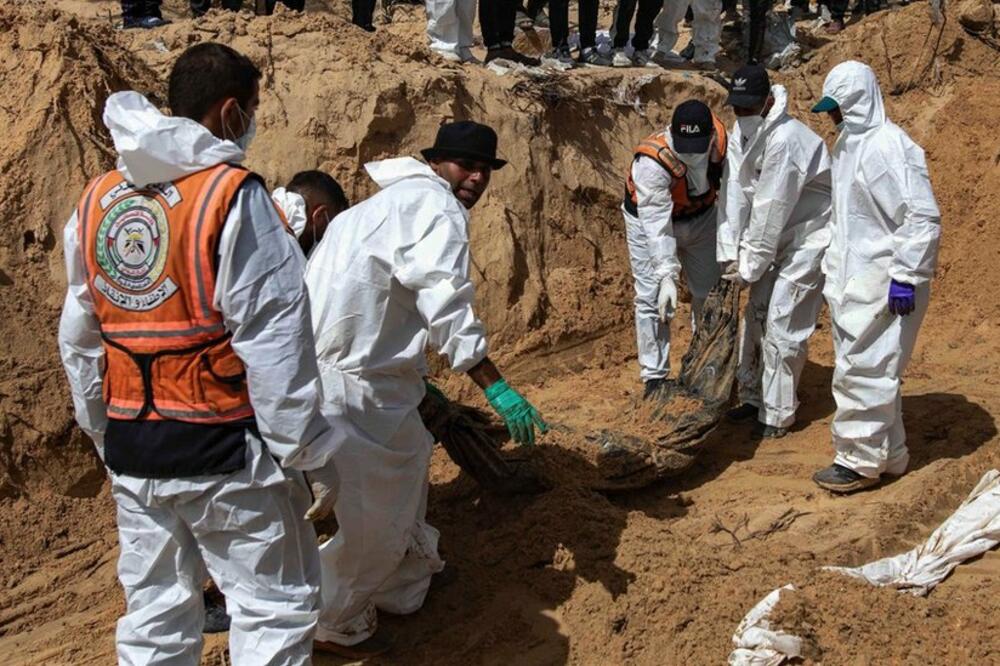In the chaos of war in Gaza, many are searching for loved ones who were last seen alive in the Nasser Hospital complex. The families know their missing relative was there, but lost contact with her when Israeli forces took control of the facility.
Now the services are excavating several mass graves in the hospital yard.
The Palestinian Civil Defense accuses the Israeli Defense Forces (IDF) of killing hundreds of Palestinians in the greater Khan Younis area, and then transferring their bodies to the Nasser Medical Complex.
However, they leave the possibility that some graves were dug before that time.
The IDF took control after entering the compound between February 15 and 22, and then between March 26 and April 7.
Exhumation of the body
Palestinian officials said they exhumed 283 bodies in Nasser, some of them with their hands tied.
It is not known how people died or when their bodies were buried.
The UN High Commissioner for Human Rights said he was "appalled" by the graves and destruction of the Nasser and Al Shifa hospitals in Gaza.
Folker Turk called for an independent investigation.
The Israeli army announced that the claims that it was burying the bodies were "baseless".
- Doctors in Gaza to BBC: Israeli soldiers beat and humiliated us after hospital raid
- UN "appalled" by reports of mass graves in Gaza hospitals
- UN legal investigator accuses Israel of genocide in Gaza
Freed Israeli hostages held by Hamas said they were held at Nasser Hospital for long periods of time during their captivity.
BBC News in Arabic spoke to Uma Muhammad Zidan - a mother looking for her son Nabil.
She was going to the mass grave to check if his body was there.
Her steps were heavy, she says, as she carried a bouquet of roses, bottles of perfume and eucalyptus oil.
She told how she desperately searched for her son's body to shower him with flowers and perfume - as she would have done at his wedding - because before the war she had promised to marry him and throw him a big wedding.
The BBC News Arabic Forensic Team searched for available evidence to support what happened at Nasser Hospital.
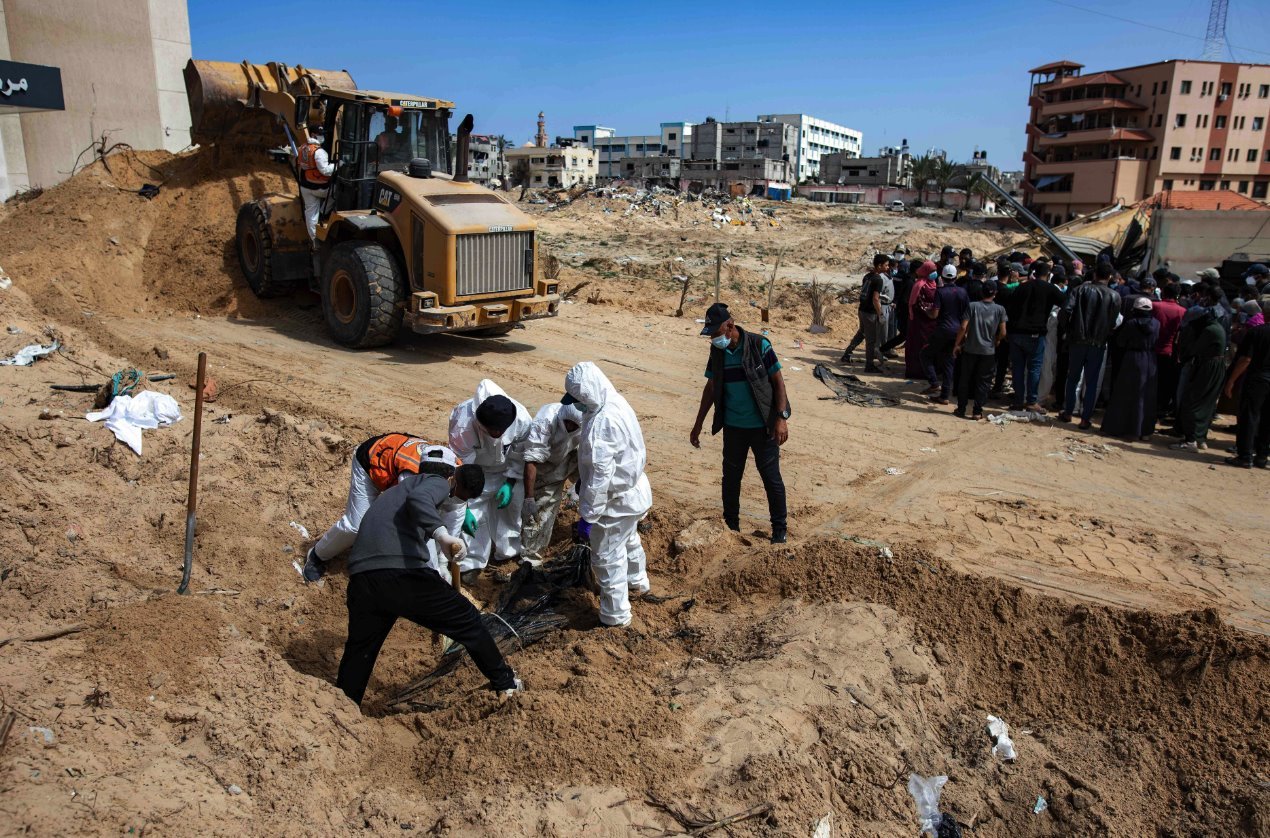
Proving that mass graves exist
The presence of a body at the location can be seen in this video, dated April 21.
It shows the Palestinian Civil Defense finding graves and trying to identify the bodies.
Locations
Landmarks of the site match a video released on January 25, showing Palestinian civilians burying more than 70 bodies in the courtyard of Nasser Hospital.
The buildings match those seen in the April 21 video.
Claims of a mass grave are backed up by an eyewitness who told the BBC: “I saw skulls buried in the ground, several arms and legs, rotting bodies. The stench was terrible."
Did the Israelis dig mass graves?
Mahmoud Basal, the spokesman for the Palestinian Civil Defense, states that around eighty bodies were found on the first day, and around thirty of them were identified due to clear markings.
He says that it is impossible to identify the others because they were buried on different dates, with the suggestion that the bodies are in the stage of decomposition.
After the raid on the hospital, Israeli forces dug up graves in search of the bodies of the Israeli hostages, Basal said.
He adds that the soldiers brought back the bodies of the people killed during their incursion.
In a statement to the BBC, the IDF said: "The allegation that the IDF buried Palestinian bodies is baseless and unsubstantiated."
"During the IDF operation in the Nasser Hospital area, in line with efforts to find hostages and missing persons, bodies buried by Palestinians in the Nasser Hospital compound were examined...
"The examined bodies, which did not belong to the Israeli hostages, were returned to their place," the IDF told the BBC.
Statements by a spokesman for the Palestinian Civil Defense agree with the Israeli version of what happened.
However, this does not rule out the possibility that more graves were added after Israeli forces stormed the hospital.
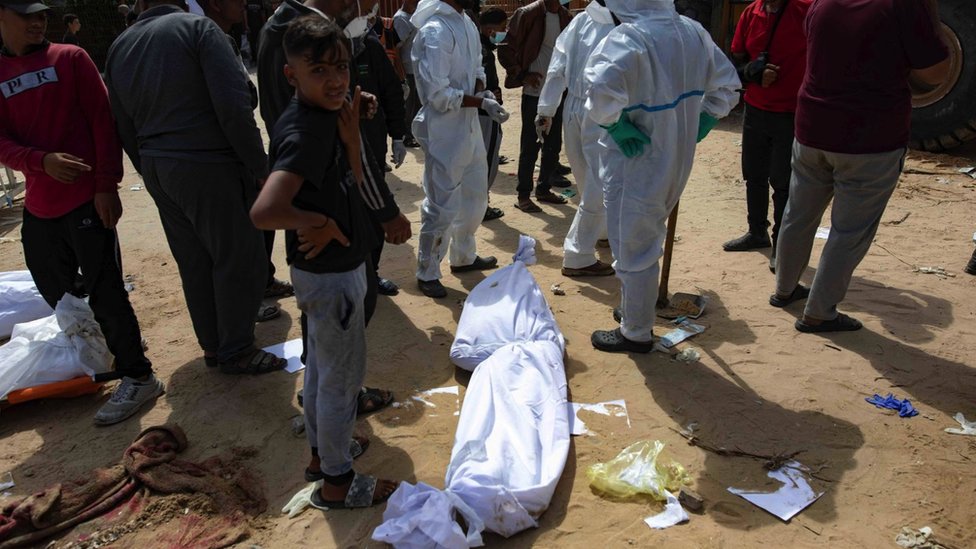
What does the evidence tell us about buried bodies?
The mass graves are located in the same area where civilians, families and paramedics have buried dozens of Palestinians in recent months.
Palestinian civilians burying the bodies of other Palestinians can also be seen in other footage dated January 28.
About thirty people were buried there.
On February 28rd, another group of bodies was buried at a location six meters from the spot shown in the video from January XNUMXth.
Mahmoud Basal of the Palestinian Civil Defense told the BBC that Palestinians buried their own relatives and unidentified bodies at these hospital sites.
He said the men were killed during what he called the "Israeli siege" of Khan Yunis.
On January 22, the Hamas-run Gaza Health Ministry said dozens of people were killed or wounded west of Khan Yunis.
The ministry said people were forced to bury 40 bodies within the grounds of Nasser Hospital because everything else was unsafe.
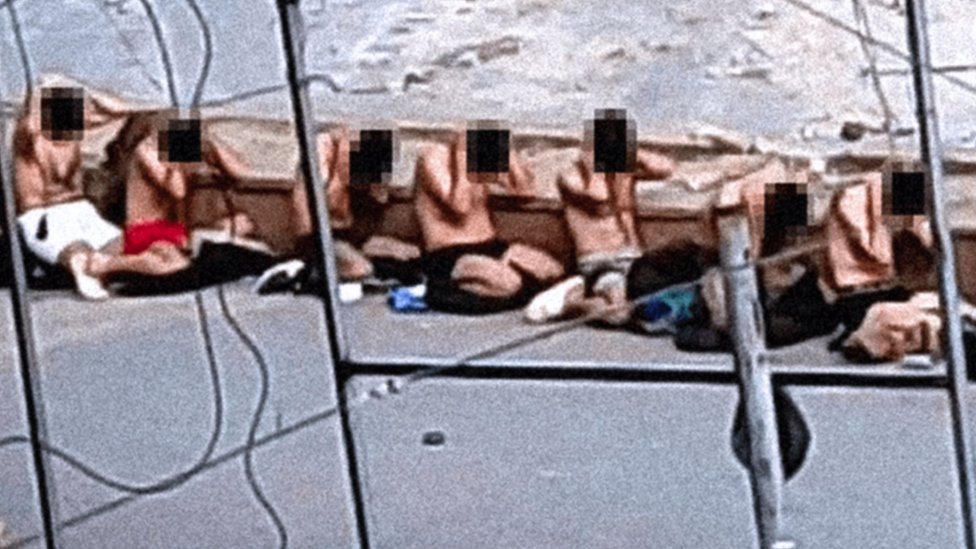
What evidence is there that Israeli soldiers abused prisoners?
The photo shows a partially decomposed body that appears to be bound, suggesting it could belong to someone taken into custody by Israeli forces.
In a response to the BBC, the Israeli military said the operation was carried out "targetedly without harming the hospital, patients or medical staff".
However, three members of medical staff told the BBC last month that they were humiliated, beaten, doused with cold water and forced to kneel for hours after being detained during the raid.
The BBC obtained a video that was forwarded to it by an eyewitness inside Nasser Hospital, where Israeli soldiers can be seen moving beds with people, whose hands are tied and raised above their heads.
This was backed up by separate footage released by the Israeli military, showing people lying on hospital beds with their hands tied in a similar fashion.
We do not know who the individuals in question are, nor what happened to them after the recordings were made.
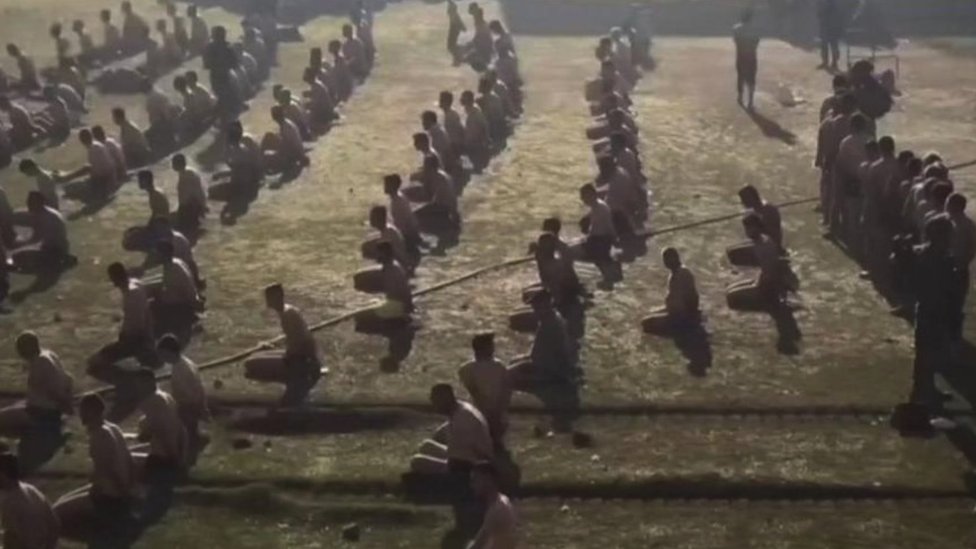
Missing body parts
Ismail Al Tawabata, director of the government's media office in Gaza, said Israeli soldiers stripped dozens of patients, displaced persons and medical staff to their skin before "executing them".
He added that "inside the Nasser complex, they found corpses without heads and bodies without skin, and that some of them had their organs stolen".
He requested an international investigation.
Palestinian doctor Ahmed Abu Mustafa from Nasser Hospital told the BBC that they found bodies with missing limbs.
He said one belonged to a member of the medical staff, whom they were able to identify based on the uniform he was wearing.
He was handcuffed and his features were hidden, he said.
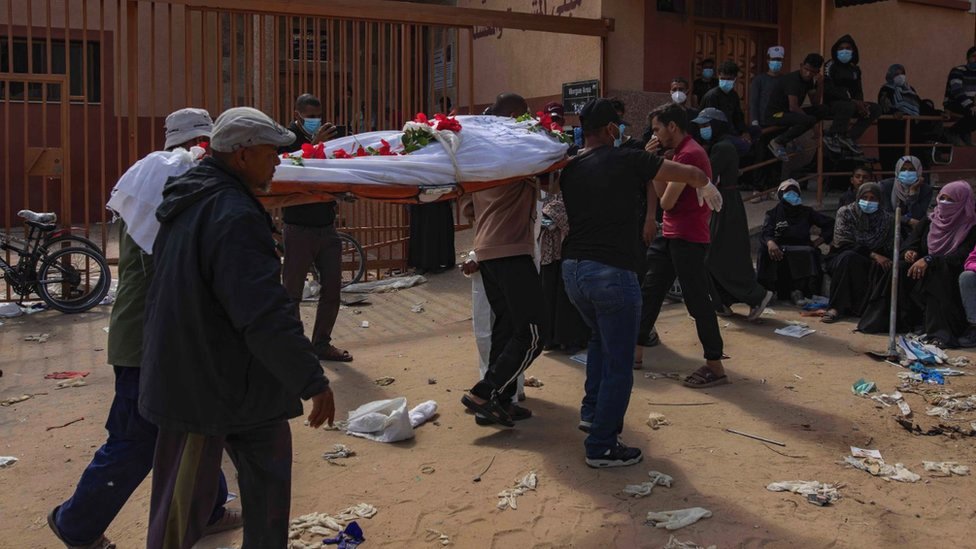
The IDF has denied allegations of atrocities, saying its forces detained "about 200 terrorists who were in the hospital" during the raid and found ammunition and unused medicine intended for Israeli hostages.
We showed our collection of recordings and images to Dr. Hasanein Al Tayer, a forensic medical consultant and lecturer at the UK's Oxford University.
He confirmed that he noticed bodies in different stages of decomposition on the videos, which indicates different times of burial.
Al Tayer's opinion, based on what he saw in the videos and photographs, is that the wounds and cuts on the bodies visible in the videos could not have been inflicted by dismemberment, but rather by heavy weapons.
He says that it is common for body parts to be lost in the rubble when houses or cars are bombed.
A body without a head
A photo of a headless body has been circulating on social media with claims that it is one of those excavated from recently discovered mass graves.
However, Al Tajar says the condition of the corpse and visible blood indicate that the photograph was not taken more than a day after the person's death.
This refutes the idea that the body is of someone who was killed before the Israeli withdrawal on April 7.
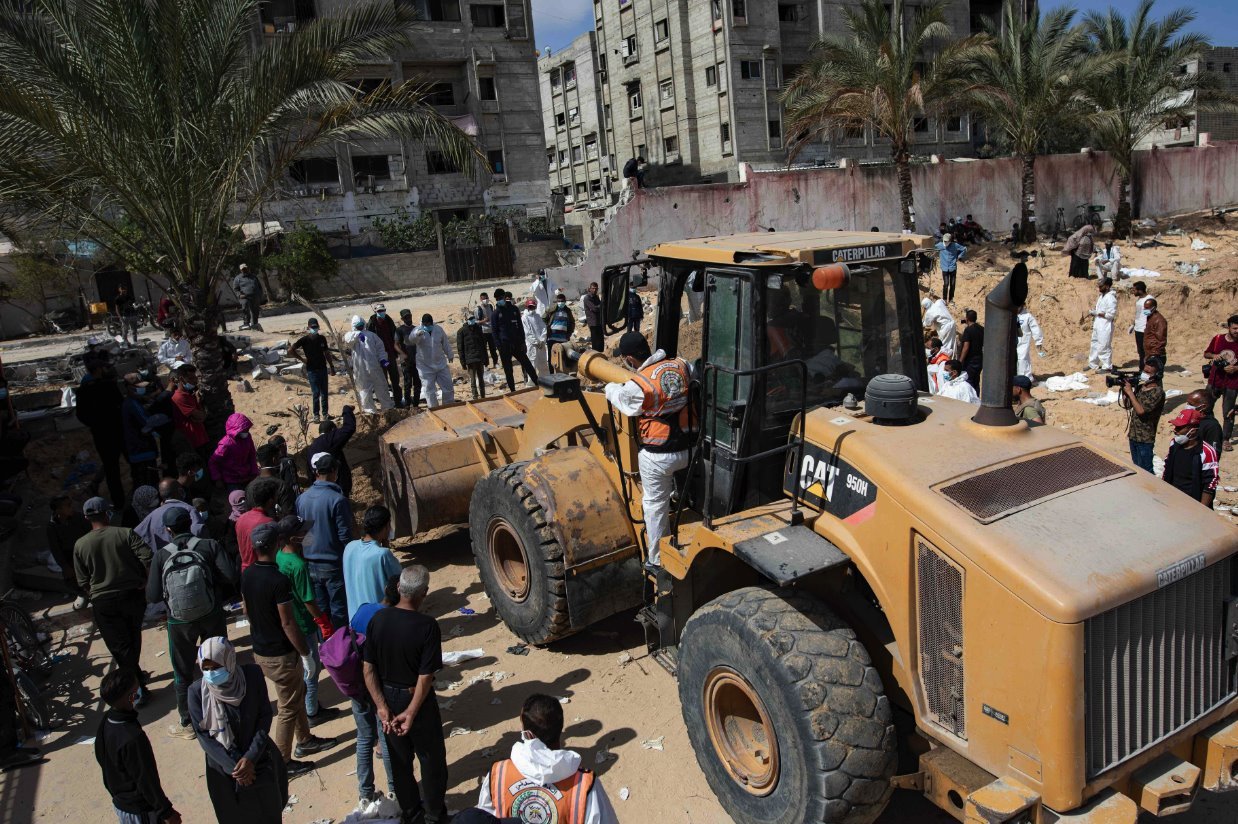
What did the UN do?
A spokeswoman for the United Nations High Commissioner for Human Rights said that they are currently working to corroborate reports by Palestinian officials that 283 bodies were found on the grounds of Nasser Hospital, of which 42 have been identified.
UN High Commissioner for Human Rights Folker Turk called is for independent, efficient and transparent investigations: "Given the prevailing climate of impunity, this should involve international investigators".
"According to international law, hospitals have the right to special protection. The deliberate killing of civilians, detainees and others not taking part in hostilities is a war crime."
The US State Department also expressed concern, saying the reports were "incredibly disturbing".
Report contributors Gada Nased and Andrew Webb
Follow us on Facebook, Twitter, Instagram, YouTube i Viber. If you have a topic proposal for us, contact us at bbcnasrpskom@bbc.co.uk
Bonus video:



